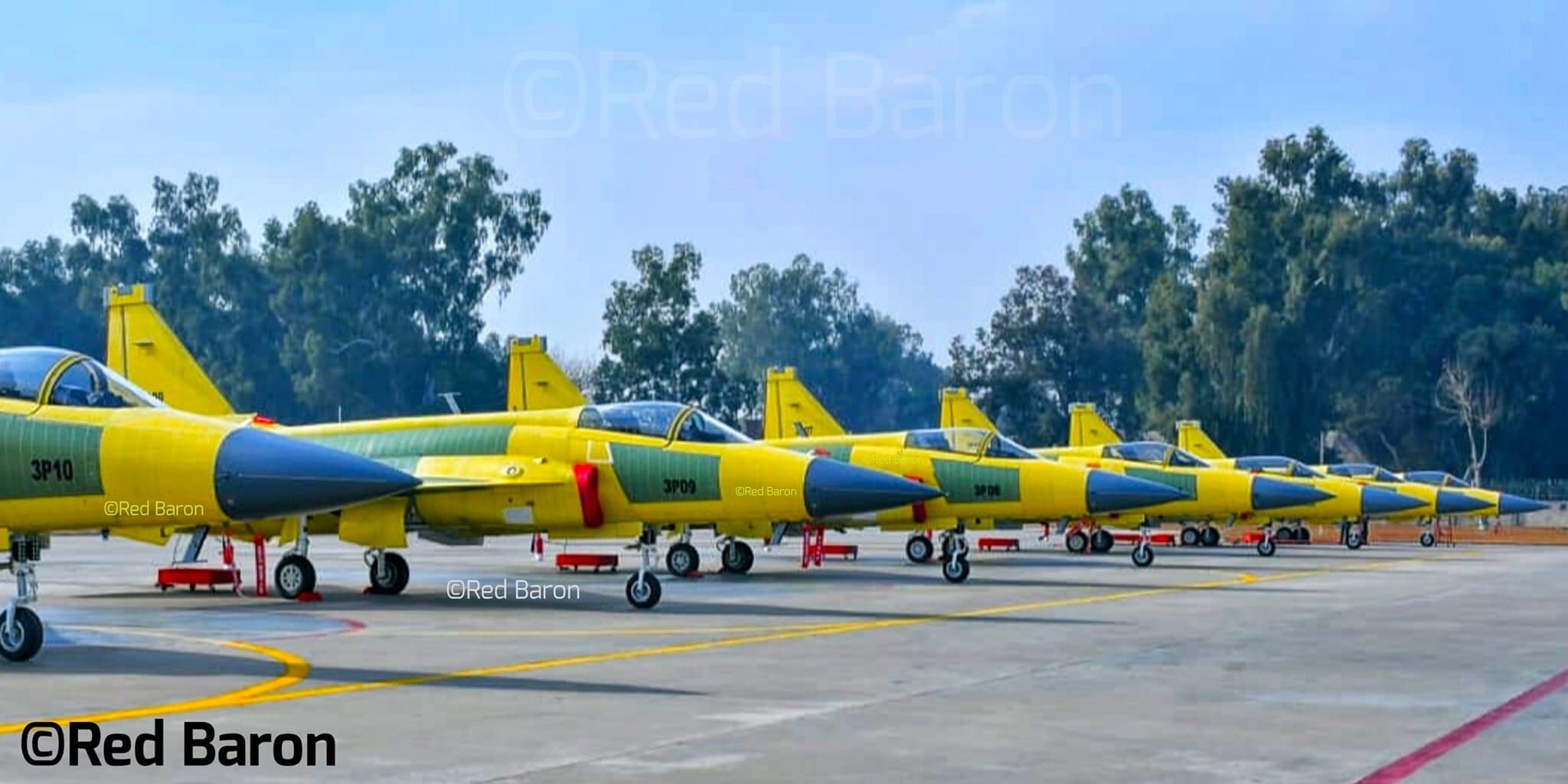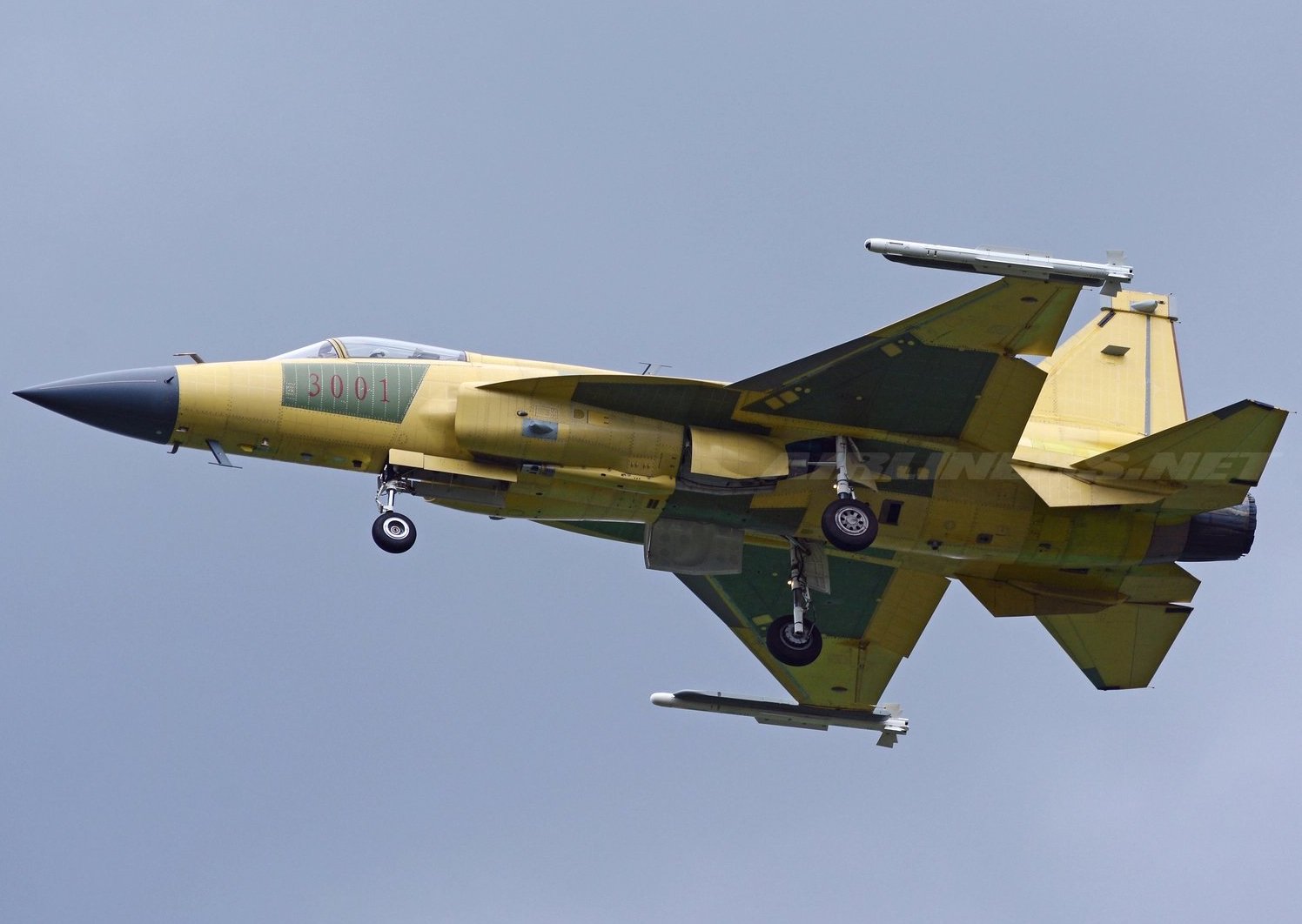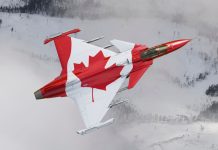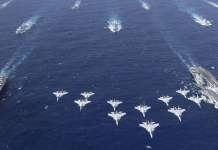Photos of the first mass-produced version of the JF-17 Block III fighter have surfaced on social media, suggesting that the model may enter Pakistani service soon. The fighter jets are expected to be produced in China and assembled in Pakistan.
Since China does not ‘trust’ these fighters, even as a cheap replacement for the obsolete J-7’s and J-8’s, the JF-17 fighter jet is explicitly built for export.
Like the previous models of the JF-17, the Pakistan Air Force (PAF) is expected to be the primary customer for this model. The Chinese feel the new model could attract more interest from foreign customers as it has a substantial increase in the new capabilities.
The latest block of JF-17 appears to be a game-changer for the technology-starved Pakistan’s air combat capabilities as it boasts limited stealth, a more powerful engine, a bigger KLJ-7A AESA radar, and the first infrared search and track system (IRST) on a Pakistani fighter jet.
Like the FC-20E, a J-10C lookalike that Pakistan claimed to have purchased from China, the JF-17 Block III will also feature the AESA radar, providing enhanced situational awareness and interference immunity from electronic warfare while providing offensive electronic warfare options to the PAF.

Since the JF-17 is one of the lightest fighter jets in the world, it has a similar weight as that of the Swedish Gripen and the US F-16 and can accommodate relatively small radars. Integrating a more advanced radar compensates for the radar limitation.
The light fighters are considered a good fit for Pakistan’s defense budget because of their extremely low cost of operation and maintenance as well as their high availability rate, which means that the majority of the fleet is ready for combat at any time.
However, this low-cost design comes at the expense of flight performance. The fighter is not particularly nimble, which is compensated for by equipping the PL-10E short-range air-to-air missile capable of striking targets at very extreme angles but at a range of about 20 km. This is the primary air-to-air armament of the JF-17 fighter Block III model.

In addition to improvements in sensors and avionics, the armament of the PL-15 long-range air-to-air missile is considered the most notable feature of the new fighter. The PL-15 has an estimated 200 km range (or more depending upon many factors like release height, angle of attack etc.), far exceeding most of India’s existing air-to-air missiles, such as the 80 km MICA missiles used by the Rafale jets.
The PL-15 outranges any missile fielded by the Indian Air Force Mirage 2000 fighter jets and the MiG-21. The MiG-29 and Su-30MKI use the R-77 missile with a range of 110 kilometers.
The only exception is the older Novator K-100 missiles of the Su-30MKI, which pose a low threat to fighter jets and are designed to engage large support aircraft at a range of 300 km, and the Meteor missiles purchased for the Rafale fighters with an estimated range of 200 km.
But the use of PL-15 against a fighter-sized target is not confirmed by China and is only a speculation. According to experts, this missile is more likely to be used against support aircraft like the AWACS and tankers. China claims PL-15 has a more extended range than its predecessors and uses its own AESA radar for guidance, giving it an advantage over western and Russian designs.
Another interesting feature of the Chinese claim is a new holographic wide-angle head display and integrated cockpit display, similar to that used on the Chinese J-20.
That brings us to the engine of JF-17, which is already considered underpowered. These modifications are possible only if the Russians have supplied the Chinese with a more powerful engine or the Chinese have completed building the WS-13 engine intended for the JF-17. The Pakistanis had rejected this engine for the former blocks of the aircraft.
The Russians have tested the RD-93MA engine, which is suitable for the new aircraft model. Open-source information reveals that the RD-93MA engine has 9300 Kgf thurst compared to 8300 kgf of the RD-93 that powers the JF-17 block I and II. The Russians have not yet reported the sale of this engine.
The advanced performance of the JF-17 Block III is expected to make it more attractive than previous versions. With Pakistan likely to field more than 100 of these fighter jets, including single- and two-seat versions. The JF-17 Block III is expected to revolutionize Pakistan’s ability to defend its airspace and serve as a light companion to the JF-20E fighter jets.
F-16 Design Elements In JF-17 Thunder?
In November 2021, The EurAsian Times reported that Azerbaijan seemed to be interested in purchasing the JF-17 Block III variant.
Since the 1950s, Islamabad and Beijing have remained key allies, with India serving as a common foe throughout the Cold War. Given that Islamabad was a strong ally of the US in the fight against the Soviets in Afghanistan, Pakistan could even be considered a bridge between Beijing and Washington at one point in time.

Afghan and Soviet planes often targeted the camps where the mujahideen were being trained and armed by Washington and Islamabad.
The Pakistan Air Force’s (PAF) Chinese-made jets were slow, prompting it to look for the American F-16s to enhance its airpower. Through Operations Peace Gate I and II, a total of 28 F-16As and 12 two-seat F-16Bs were supplied to Pakistan via Saudi Arabia between October 1982 and 1986.
In the 1990s, Pakistan sought a new fighter plane from China. The request was made for two reasons: first, to replace Pakistan’s outdated Chinese-built J-7 and A-6 aircraft (said to be Chinese clones of the Soviet MiG-21 and MiG-19, respectively), and the second, as the Soviets prepared to field their next-generation MiG-29 lightweight fighter, Pakistan needed an aircraft to counter it.
This led to Project Sabre II, a joint effort by China’s Chengdu Aircraft Industry Corporation (CAC) and the American company Grumman to modernize the J-7s. The original plan was to expand the J-7’s fuselage, alter the control surfaces, and relocate and resize the air intakes.
However, the project fell short of the developers’ objectives, and Project Sabre II was shelved.
The three countries had actually attempted a cooperative venture in the 1980s called Super-7 to produce an enhanced J-7 fighter, which would use F-16 avionics. Following the events in Beijing’s Tiananmen Square in 1989, the US government forbade American corporations from cooperating with China, forcing Grumman to quit the program.
China-Russia-Pakistan Collaboration
CAC continued to work on the Super-7 project, and in the 1990s, it proposed to collaborate with the Pakistan Aeronautical Complex to produce a cheaper F-16 replacement named JF-17 Thunder based on the Super-7. The Super 7 was revived in 1998 by China and Pakistan and both split the expenses on a 50/50 basis.

The fighter needed a new powertrain after Grumman withdrew, therefore the Russian Mikoyan Design Bureau supplied the Klimov RD-93 engine. The RD-93 was a more advanced variant of the RD-33 used in the MiG-29; although, the JF-17 only has one RD-93, whereas the MiG-29 has two RD-33s.
The incorporation of diverterless supersonic intakes (DSI) on the JF-17 design was another major innovation made throughout the development phase. In addition, the Thunder employs an RD-93 turbofan with lower fuselage intakes instead of the MiG-21’s R-25 turbojet with a nose intake.
Engineers from China, Pakistan, and Russia incorporated a better wing, similar to the F-16’s wing, as well as diverterless intakes that perform equally well at high and low speeds.
Although it is slightly slower than its Soviet counterpart in terms of speed, the Thunder is significantly more agile, has a range of roughly 750 miles, and its KLJ-7 doppler radar is far more effective.
Unlike the F-16, the JF-17 is equipped with Chinese weaponry such as the PL-5 short-range air-to-air missile, LS-6 GPS-guided glide bombs, and YJ-12 supersonic and YJ-83 subsonic anti-shipping missiles.
Production began in China in 2006 and was quickly relocated to a facility in Pakistan. The Block I JF-17s were the first batch of fighters built for the Pakistan Air Force. Block II JF-17s added dozens of new features and improvements, especially composites in the airframe for weight savings, air-to-air refueling, a full fly-by-wire system, and improved radar.
Block III has an AESA radar, a helmet-mounted targeting system, an upgraded targeting pod, data linkages, and weaponry beyond visual range.
Although it is a descendant of the 60-year-old MiG-21, the JF-17 is a totally modern and cost-effective warplane. With the support and extra design ideas from the F-16, China has modernized the last generation’s budget fighter, the MiG-21, for the current era in many respects.
(Joseph P Chacko is a publisher, columnist and author. He writes on defense and strategic affairs and occasionally other topics. He tweets @chackojoseph)




